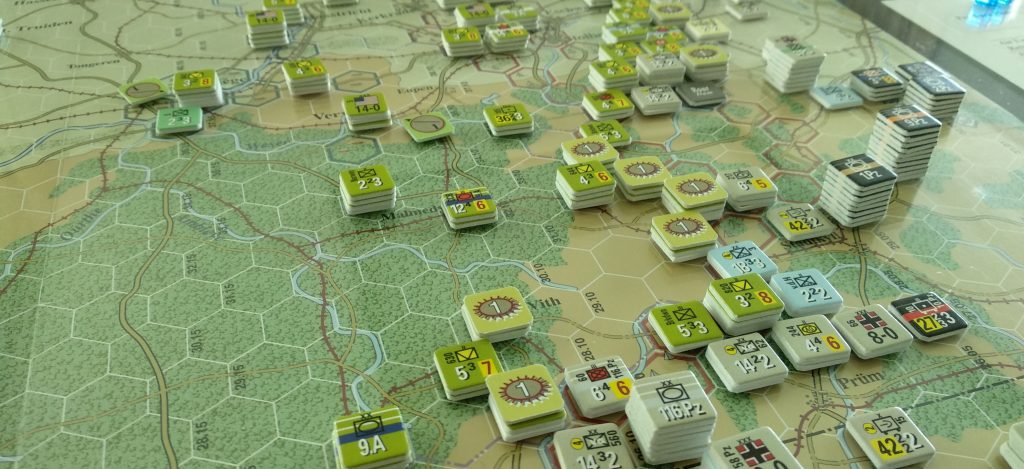Along with my fairly frequent plays of ASL I’ve picked up a copy Tunisia II. A module in the Operational Combat Series (OCS), which like ASL, is also published by Multi Man Publishing (I’m in danger of becoming a bit of a fan boy). The system emulates operational level conflicts and in this case it depicts the end of the German Afrika Korps. One of my main reasons for trying out this particular system was the units dependence on supply. An important issue that faced many commanders in the field yet is often glossed over when interpreted onto board and screen. German shortages late in WWII were critical, leaving many planes grounded and armour abandoned! (Wiki article covering Blitzkrieg – check the logistics section). OCS requires that units not only trace supply to friendly sources, much like many other wargame systems, but to also have supply points available on-map that can be spent for movement (trucks and track based vehicles), and also spent to attack, defend, refit aircraft, build defences, etc. This leads to constant wrangling of not only where to best place units, but to ensure that enough supply is ready and available when and where it is required.
Amateurs talk about tactics, but professionals study logistics
General Robert H. Barrow
 Another aspect of the higher level of operation (compared to ASL) is the clearly defined battle fronts that can be hard to break down. OCS games have very porous zones of control (descriptive quote from Big Board Gaming), and although the only units that are stopped in an enemy ZOC are ones that use truck movement points the units that do make the break through will still require supply from the HQ’s via their truck movement point “throw” range. This effectively means that pretty much all infantry and armour are able to break the lines, however that could then put them out of supply unless the breach can be widened or the units can be directly supplied using on-map supply points. This leads to an interesting tug-of-war as each player struggles to make headway.
Another aspect of the higher level of operation (compared to ASL) is the clearly defined battle fronts that can be hard to break down. OCS games have very porous zones of control (descriptive quote from Big Board Gaming), and although the only units that are stopped in an enemy ZOC are ones that use truck movement points the units that do make the break through will still require supply from the HQ’s via their truck movement point “throw” range. This effectively means that pretty much all infantry and armour are able to break the lines, however that could then put them out of supply unless the breach can be widened or the units can be directly supplied using on-map supply points. This leads to an interesting tug-of-war as each player struggles to make headway.
OCS games have very porous zones of control
Plagiarized and possibly paraphrased from Kevin of the excellent Big Board Gaming
The main complaint I’ve seen levied at OCS is due to the limited supply resulting in some units never actually fighting (or even moving) during an entire scenario. While possibly a valid complaint, although I’ve no idea how often motorized units ground to a halt or were held back due to shortages in reality during the WWII, I feel that in this game the supply is more a representation of where “extra” is being allotted for big pushes. Thus, units adjacent to the enemy, while no dice are actually being thrown, are still engaged but not actively trying to push forward. I guess my point is that all games are an abstraction to varying degrees and the ability to move and fight with every unit in OCS, especially in some of the larger titles (see Beyond the Rhine below) would most likely take an unreasonable amount of time and possibly paperwork just remembering which units had been in combat or otherwise activated.

The game so far is extremely enjoyable and played at a much slower pace than ASL. Moves can often take an hour or so to mull while considering the consequences. During the actual movement the other player is by no means left with nothing to do. They are – to some extent – able to react if units had been set up in reserve.
I’ll see if I can get my son, or another willing participant to give the game a go before I can say if it sits firmly in my favourites list. But so far it really is rather good.

